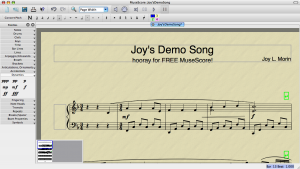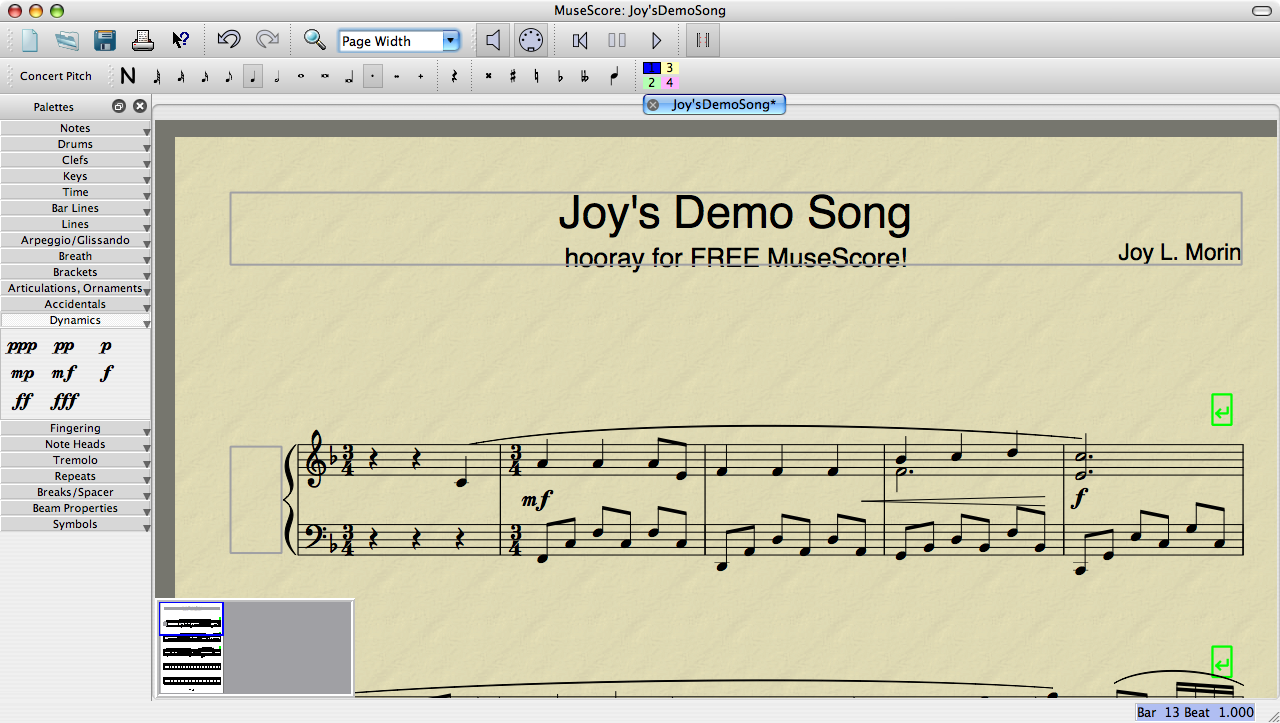
Move over, Finale and Sibelius! There’s somebody new in town. MuseScore is a music notation software available FREE online for anyone to download. After doing a brief test drive last spring (mentioned here), I decided to take a closer look now that it’s available for Mac users.
I’ve been a faithful Finale user since 2005, mainly because Finale is the software of choice at the colleges I’ve attended. I use Finale to make worksheets for my students and to notate my original compositions and arrangements. Buying Finale 2009 last September cost me an arm and a leg, so I was quite curious to see how MuseScore would compare. Is it worth spending all that money on Finale when you can get MuseScore for free?
And there’s another reason why I was curious about MuseScore. Was anybody else as “bummed” as I was when Finale began charging $9.95 to download their demo version of Finale, “Finale Notepad“? Finale Notepad was perfect to recommend for students who just wanted to enter simple compositions and be able to print them off. And the basics were all there, but you couldn’t do certain things, such as changing the key signature or time signature in the middle of the piece. Now that Finale Notepad is no longer free, MuseScore is looking even more appealing — especially when you take a look at this chart that compares the two side-by-side.
![Joy'sDemoSong Here's the end result. [click to enlarge]](https://colorinmypiano.flywheelsites.com/wp-content/uploads/2009/08/JoysDemoSong-211x300.jpg)
My test drive of MuseScore 0.9.5 for Mac:
As with any notation software, it takes time to learn the shortcuts and find where everything is located. For the most part, I was able to figure out how to do the things I wanted to do. But I did run into a few difficulties:
- Editing the pickup measure (after already going through the setup wizard). The Help Manual says to right-click on the measure and select “Measure Properties”, but when I right-click on the measure, nothing happens. (On MacBooks, you normally hold “Ctl” and then click in order to right-click, but MuseScore doesn’t seem to be recognizing this. If you have a PC, you are likely to have no issues with this.)
- Was unable to delete extra measures I didn’t need, due to the same issue as above: was unable to get into the “Measure Properties” menu.
- Inserting a tie (supposedly, you are supposed to push the “+” button, but if you take a look at the + key, it’s actually a =/+ key, which means getting the plus sign requires using the shift key. But pressing “shift +” is apparently a different shortcut. So I’m confused.)
- Hiding a rest in Voice 2 (Finale calls them layers) so that it’s not covering the notes in Voice 1. (Refer to m. 13 to see what I’m talking about.) Again, I was supposed to right-click and click “Set Invisible”, but MuseScore is not recognizing my right-click on my MacBook.
- I was unable to find a way to insert a ritardando. Did I miss it somehow? So I just entered “rit.” as text, which means the playback unfortunately will not recognize the ritardando.
- I normally like to hide the measure numbers for most projects. I was unable to figure out how to do this in MuseScore, so I assume it’s not a feature (yet).
But here are the “pros“:
- It’s FREE. What more can I say?
- There is the pdf Help Manual (included in the download, easily located in the “Help” dropdown), an Online Help Manual where you can learn how to enter the items you need in your score. In addition, the website has an online forum where you can ask questions and get answers.
- After entering all your notes, the score still looks fairly neat and clean. MuseScore automatically adjusts the measures so the notes aren’t cramped-looking. Sometimes Finale makes your score look cluttered and messy if you have a lot of items entered.
- It is much easier not to accidently “overfill” a measure, as it is in Finale. MuseScore automatically fixes the measure so it contains the proper amount of beats as it is supposed to have for that particular time signature.
- The piano synthesizer sound for the playback seems decent . . .not great, but decent.
- Once your project is finished, you can save it as a pdf, midi sound file, or wav sound file, among other forms.
And so what are the results of my little evaluation? Here’s what I think:
In short, I would say keep your eye on MuseScore. It seems they have some bugs to work out yet, particularly in the version for Macs. But the basic functions were all there and were fairly straightforward to use. MuseScore looks very promising for the active composer/arranger. It may be more difficult for the teacher to switch over, because I’m not sure how easy making worksheets would be in MuseScore. Am I ready to leave Finale yet? Not yet . . .but maybe when the bugs for Macs are worked out.
However, I would not hesitate to recommend MuseScore to my students. Let’s face it: kids are naturally technology-savvy, and (with the help of the Help Manual) would likely be able to use the basic functions of MuseScore with little difficulty.
With all that in mind, take a look for yourself. The images in this post include a screenshot of the little song I composed on the fly at I tested out MuseScore. You can even listen to a Midi file of the demo song by clicking here: Joy’sDemoSong. What are your overall thoughts?



Hi,
Thanks for the review! And thanks for the mac user insight!
A couple of answer to your questions/problem
– Right click. I use the trackpad and click with two fingers on my macbook. Ctrl + click needs to be added indeed.
– Tie : I use the num pad +. To enable the numpad, press F5 then you can use the + key. Numpad
– Ritardando. It’s in but it’s a bit tricky. Select a note head, Alt + ? + T to insert a tempo text, choose the new BPM, click OK. Then double click the tempo text to edit it.
– Hide measure numbers. In the menu choose Style -> Edit Style -> Numbers -> Untick the Measure Number checkbox
– Delete measures. Select measures by ? + Click and use the Supp key
– Other piano or instruments sounds can be added with a Soundfont.
Everything is in the handbook or the forum, the search feature on musescore.org is quite powerful.
Hope it helps. Thanks again for the post.
Lasconic
Cmd sign has been changed to ?
Sorry for that…
@lasconic
Thanks for clearing up those items for me! Unfortunately, my MacBook must be older than yours — because I can’t do the whole click-with-two-fingers thing on mine. 🙂 But, pray tell, what is the “Supp” key that you referred to?
The delete key? Del ? or Suppress? Supp?
ohhhhhhhhhh, okay! I can handle that. Wow, is that weird that I have never heard of the Supp key? haha.
Thanks for all your help, lacsonic. Visit again soon!
I’ve just realized that some macbooks do not have supp nor delete keys 🙂
You can achieve the same result with Fn + Backspace.
I’m using MuseScore 0.9.5 for Mac (on my MacBook Pro, which has no num pad) tonight for the first time and can’t figure out how to get a tie to appear. The only + on my keyboard is the +/= key and that’s not working. Anyone else figure this out?
I am a Finale user, too. This is the first time I have heard of MuseScore. Most of my peers use Finale as well. I’m really excited to try out MuseScore because I also make worksheets and edit music for particular instrumentations. How exciting that they offer it free!
Thanks for the links.
.-= The Flight Sim´s last blog ..PC Flight Simulator =-.
Thanks for a great blog. There is some really great information on here and I am sure your regular readers (of which I am about to become) get a lot from it. Thankyou
.-= MP3 Player 8GB´s last blog ..MP3 Player 8GB =-.
Thanks for a very informative blog! I’m not a Mac user myself, so I hope it will work better for my PC. I just get songs (melodies as well as words) in my head sometimes that I’d like to write down, but I’m horrible at reading and writing music, so I was looking for recommendations on various software. I need to investigate a bit more before committing to one, but this gives me a great starting point. ^_^
Cool software. As I can’t read a music note then I have nothing to do with. But It’s look like very cool. Maybe I can suggest to my friends.. Lol
.-= Peter Jay´s last blog ..Our Very Very Own BRC Toolbar =-.
I’m getting into MuseScore but I’ve never used Finale or Sibelius. On playback, musescore seems to ignore a lot of my articulation markings. For instance, it will play a staccato note, but not marcato. I’m wondering if some of the articulation and accent markings are too subtle for MIDI playback, or if MuseScore lacks the sophistication I’m looking for. I, too, am a MacBook user, FYI.
Thanks,
Andy
I’m not sure about this, Andy. This would be a great question to ask the folks over at the MuseScore website. Good luck!
I use MuseScore 1.1 in conjunction with LMMS on Linux.. MuseScore gives me good sheet music, and LMMS helps me specify the sounds I want. Good free software is out there and gaining traction (all these are free). I’ve used Cubase before, and Muse Score and LMMS are just as good.
This post will save me a lot of stress this semester! I had never heard of MuseScore before. I am in an orchestration and arranging class and my prof encouraged us to purchase Finale, but I just can’t afford it right now. This will do the job!
Thanks SO much!
Thanks for the review. I have used Musescore a couple of times for minor things. I normally use Finale. But it is good for people who can’t afford the high price of Finale to have a free alternative.
Paige
P.S. I wanted to make a gentle suggestion as I have seen this usage more and more in recent years. You titled your demo as “Joy’s Song.” A song by definition has words. Your demo has no words, hence, it is not a “song.” It seems inappropriate to me to expand the meaning of this old, perfectly useful word to mean any short piece of music. If that becomes increasingly common what word do we use to mean a piece intended to be sung as opposed to a instrumental piece?